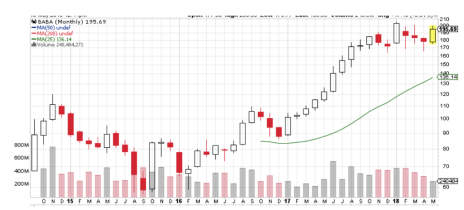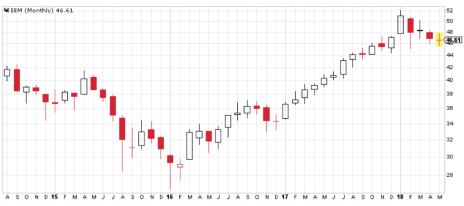IPOs can be exciting, and a big one can make headlines that break out of the financial sector’s narrow focus. (Remember when Alibaba’s (BABA) record-breaking initial offering was breaking records back in September 2014?) But there haven’t been a lot of new Chinese stocks coming public in the past couple of years. After a surge of China IPOs in 2014, just four stocks of Chinese companies listed on U.S. exchanges in 2015 and just seven came public in 2016.
China IPOs on the Uptick?
As always with matters relating to China, it was a government decision that led the reduction of IPOs to a trickle. Exactly why government officials turned off the spigot isn’t clear, but the most reasonable explanation is that China wanted to be sure that there wouldn’t be a repeat of scandals like the Evergrande Real Estate Group debacle of 2012 and several unsavory companies that acquired backdoor listings a few years later.
That logjam eased slightly in 2017, with China IPOs soaring into double digits. And there has been a recent spate of IPOs from Chinese education companies that are seeking to emulate the success of major market successes like TAL Education (TAL), which has soared from 1.1 in 2012 to over 40 in recent trading, and New Oriental Education (EDU), which has jumped from 18 in September 2015 to 93 this week.
[text_ad]
IPOs have a couple of huge advantages over veteran stocks, and also a couple of big risk factors. (It’s amazing how the market always balances risk and reward. You never get one without the other.)
The first big advantage of an IPO as a potential investment is that ownership is limited. Yes, there are often private equity investors that own shares via their pre-IPO investments, but the vast majority of institutional investors are starting from scratch when a company comes public. And since it’s the activities of institutional investors who make or break a stock in the long run, having a high number of potential investors is a real advantage.
The second big advantage of an IPO is that the publicity surrounding a new listing on a U.S. exchange can pique public interest and create a buying fever that can shoot a stock higher and higher. (Think Alibaba again.)
The biggest disadvantage of IPO investing is that the volatility of a popular stock can cut both ways. Speculators who try to ride the initial wave of buying often pull out as the wave peaks, producing a post-IPO droop that leaves naïve investors holding the bag.
I’ve been talking a lot about Alibaba’s IPO, so here’s the first chart. This is a monthly chart of BABA’s progress since its IPO in September 2014.
BABA came public at 68, and enjoyed a couple of months of enthusiastic buying that pushed it as high as 120 in November. But the wave of hype surrounding the initial offering was like gasoline being poured on a campfire, and there was no way to sustain that level of support, so BABA went into a nosedive that pulled it all the way down to 57 just a year after its initial offering.
The First Lesson: Beware the Post-IPO Droop!
Investors who got swept up by the excitement and bought BABA at its initial peak would have had to wait until May 2017 to get back to even on their investment. And two years and five months is a long time to have money tied up, especially when the markets were offering the kind of opportunities that emerging market stocks featured in 2016 and 2017.
The best way to avoid the hangover following an IPO party is to avoid the party in the first place. If you wait at least until the stock has been trading long enough to have a 50-day moving average, you will have a big advantage in gauging its momentum.
The second lesson from the BABA IPO shows up in this chart, which is a monthly chart of iShares MSCI Emerging Markets ETF (EEM). EEM charts the progress of all emerging market shares that trade on U.S. exchanges as American Depositary Receipts (ADRs). It’s the best measure I know of for following investors’ appetite for EM stocks. EM stocks typically fall a little more than the bulk of U.S. stocks when investors are in a risk-off mood. Here’s the chart for EEM for about the same period as BABA’s trading history.
What you see is that BABA traded very much in parallel with EEM, falling during most of 2015 and starting to gain steam during 2016. This is a pattern that shows up over and over for a huge majority of stocks, no matter whether they’re EM or U.S.
The general trend of the market is the single most important factor in the performance of all but the strongest stocks.
Certainly, there are stocks that defy the trend and rise in spite of the worst declines in the broad market. (I know because years ago I wrote a report on the strongest stocks of 2008, and there were stocks that made huge gains despite the free-fall decline of the major market indexes.)
But as a general rule, if you are looking at the chart of a stock you’re interested in, if you set your chart to include a major market index (like the S&P 500), you will see the rough parallel between the price of your stock and that of the index.
The Second Lesson: The Action of the Market Makes or Breaks IPOs.
Even with bright, shiny-faced new stocks, the market will offer either a headwind or a tailwind, and that’s hard to fight. To mix my metaphors, investing in a down market is like trying to swim upstream; you can do it, but it takes a heck of a lot more energy to do it successfully.
I know my title promised three lessons about China IPOs, but I’m going to save my third lesson for tomorrow’s Wall Street’s Best Daily column. Tune in tomorrow and I’ll feature a recent China IPO that I think has a great chance to succeed!
[author_ad]



